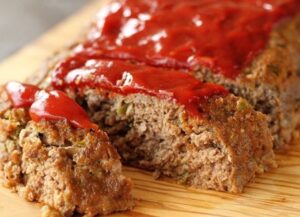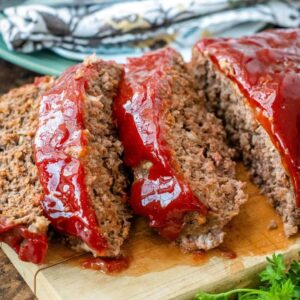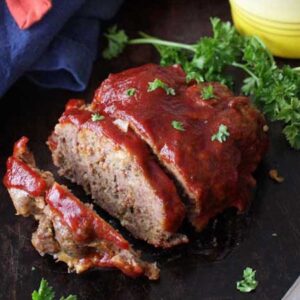Meatloaf, the quintessential comfort food

Growing up as a “baby boomer” in the 1950s, one of the foods I became painfully aware of was meatloaf. Now it’s not that I didn’t like meatloaf, it’s just that I got tired of eating it. My mom, as did many of yours I’m sure, prepared it several times a month because it was such a great dish for stretching the food budget.
But did you know this classic comfort food was not born in that or even the preceding era? Meatloaf can actually be traced back to the ancient Romans of the 4th century, where it was first noted in the Apicius, one of the world’s oldest surviving cookbooks. Named after the famous Roman cook Gavius Apicius, this collection contains more than 500 ancient recipes, from spiced wine to brain sausage, and stuffed mice. The recipe in question is titled Leporem Farsum, (translation: Stuffed Hare), which takes rabbit forcemeat mixed with pine nuts and egg, shaped into patties, wrapped in pig caul, poached in red wine broth, and finally baked.
From there, the idea of using non-meat ingredients to flavor and stretch all sorts of animal protein spread across Europe eventually finding its way to Germany and Sweden. The Germans favored boiled eggs as a way to extend their minced meat (usually rabbit) dish known as falscher hase, while the Swedish meatloaf (köttfärslimpa) used an assortment of mushrooms, cheeses and other vegetables as their fillers and served it with mashed potatoes and lingonberry sauce.
 Meatloaf’s predecessor made its way to the United States in the early 1700s by way of German immigrants that settled in southeastern Pennsylvania. These Pennsylvania Dutch communities, as they were known, brought with them the taste for “panhaas,” an old-world variant of black pudding, but lacked the wheat flour required to make it. Substituting American grains for their native ingredients they developed what is called “scrapple,” a collection of pork scraps (mainly the pigs head) mixed with cornmeal and formed into a loaf that was sliced, fried, and served for breakfast.
Meatloaf’s predecessor made its way to the United States in the early 1700s by way of German immigrants that settled in southeastern Pennsylvania. These Pennsylvania Dutch communities, as they were known, brought with them the taste for “panhaas,” an old-world variant of black pudding, but lacked the wheat flour required to make it. Substituting American grains for their native ingredients they developed what is called “scrapple,” a collection of pork scraps (mainly the pigs head) mixed with cornmeal and formed into a loaf that was sliced, fried, and served for breakfast.
Even today, scrapple remains a celebrated part of German and Swiss communities throughout Pennsylvania. It is also popular in a number of other states along the eastern seaboard where there’s a strong German influence. Primarily designed as a breakfast food to be served alongside eggs, toast, and hash browns, scrapple (aka poor man’s bacon) is now enjoyed as a sandwich meat as well. There is even annual scrapple celebrations such as the Bridgeville Apple-Scrapple Festival or Philadelphia’s Scrapplefest.
 The first known recipe for modern American meatloaf, was published on May 12, 1875 in the St. Joseph Gazette, St. Joseph, Missouri. It called for chopped leftover meat to be mixed with onions, bread, eggs, and seasonings, then “baked in a form.” It too was originally considered a breakfast meat, as was scrapple.
The first known recipe for modern American meatloaf, was published on May 12, 1875 in the St. Joseph Gazette, St. Joseph, Missouri. It called for chopped leftover meat to be mixed with onions, bread, eggs, and seasonings, then “baked in a form.” It too was originally considered a breakfast meat, as was scrapple.
Over the next several years, meatloaf recipes began to appear in a number of prominent magazines (Ladies Home Journal, 1886), newspapers (San Francisco Call, 1890), and cookbooks (National Cookery Book, 1876; Fanny Farmer Cookbook, 1896; Settlement House Cookbook, 1903). It soon became clear that meatloaf was not just for breakfast. It had become the go-to economy meal for children’s school lunches, office workers, and even the “working man’s” meal bucket, as referenced below.
“Savory Meat”
Editor Menu Column:—Probably the following will be of use: Three pounds of lean beef or veal chopped fine, six soda crackers rolled fine, three eggs, one tablespoon of salt and one of pepper, butter size of a large walnut, four tablespoons of cream, one tablespoon of mustard, one tablespoon of celery seed. Knead with the hands and shape like a roll of butter; bake two hours, basting once in a while. This is delicious for luncheon and handy to put in working man’s bucket.”
The above recipe, written by H.T.K. of Bellefonte, Pennsylvania, appeared in an 1890 issue of a local newspaper:
The first indication of meatloaf being served in a public restaurant came in 1876 when the menu of Gilmore’s Pork House was published in the Rock Island Argus, Rock Island, Illinois.
 One thing that boosted meatloaf’s popularity was the invention of the meat grinder sometime during the nineteenth century (exact date is unknown) by Karl Drais. Prior to its invention, mincing the meats for meatloaf was a very laborious job performed by hand. It wasn’t long before this hand-cranked, time-saving apparatus could be found in almost every household in America, allowing everyone the ability to easily grind their own meats.
One thing that boosted meatloaf’s popularity was the invention of the meat grinder sometime during the nineteenth century (exact date is unknown) by Karl Drais. Prior to its invention, mincing the meats for meatloaf was a very laborious job performed by hand. It wasn’t long before this hand-cranked, time-saving apparatus could be found in almost every household in America, allowing everyone the ability to easily grind their own meats.
Other events that boosted meatloaf’s popularity include the Great Depression (1929-1941), a time when the crash of the stock market, the dust bowl, and the loss of millions of jobs made cheap meals, cheap meat cuts, and leftovers a real necessity. From this catastrophic event straight into World War II, when Americans once again were forced to stretch rationed meats as far as possible, meatloaf came to the rescue. During this time recipes could be found on the labels of soups, ketchup, and cereal. By the end of the war, there were even entire cookbooks devoted to meatloaf recipes of all kinds, some very unconventional.
 So why has meatloaf proved so resilient, living on through ancient times, industrial revolutions, world wars, depressions, frozen TV dinners and more? The answer is, meatloaf not only tastes good, it is versatile! An internet search will yield a plethora of meatloaf recipes, some simple and straightforward and some not so common, like Spicy Peach Loaf and Pineapple Meatloaf. There are even vegetarian versions.
So why has meatloaf proved so resilient, living on through ancient times, industrial revolutions, world wars, depressions, frozen TV dinners and more? The answer is, meatloaf not only tastes good, it is versatile! An internet search will yield a plethora of meatloaf recipes, some simple and straightforward and some not so common, like Spicy Peach Loaf and Pineapple Meatloaf. There are even vegetarian versions.
Meatloaf’s popularity has had its share of ups and downs over the past ninety plus years, but it has stood the test of time to become America’s classic comfort food. Today, you’ll not only find meatloaf on diner menus everywhere, but more and more restaurant chefs have added upscale versions to their menus alongside fine steaks, foie gras and other upscale foods.
 An internet search for meatloaf recipes can also yield numerous tips and tricks to help take your meatloaf recipe to the next level. Here are seven tips that I feel will prove beneficial in making your next meatloaf.
An internet search for meatloaf recipes can also yield numerous tips and tricks to help take your meatloaf recipe to the next level. Here are seven tips that I feel will prove beneficial in making your next meatloaf.
-To prevent a dry meatloaf, you need to a use milk and bread “panade,” instead of dry breadcrumbs.
-Another way to ensure a moist meatloaf is to add mushrooms to your mix.
-Finely chop any vegetables used in making your loaf, as no one wants to bite into a big chunk in their slice of meatloaf.
-For a more flavorful meatloaf, try adding minced garlic, parsley, and thyme along with salt and pepper. Or, for even bolder flavor you can also add Worcestershire, Dijon mustard, or ketchup to your mix.
-Use your hands and a light touch when blending your meatloaf mixture, forming it on a rimmed sheet pan rather than in a loaf pan.
-Finish your meatloaf with a kicked up topping of ketchup blended with a bit of balsamic vinegar and Worcestershire.
-Finally, be sure to let your meatloaf rest covered for ten minutes before slicing, allowing the juices to remain in the meat.


